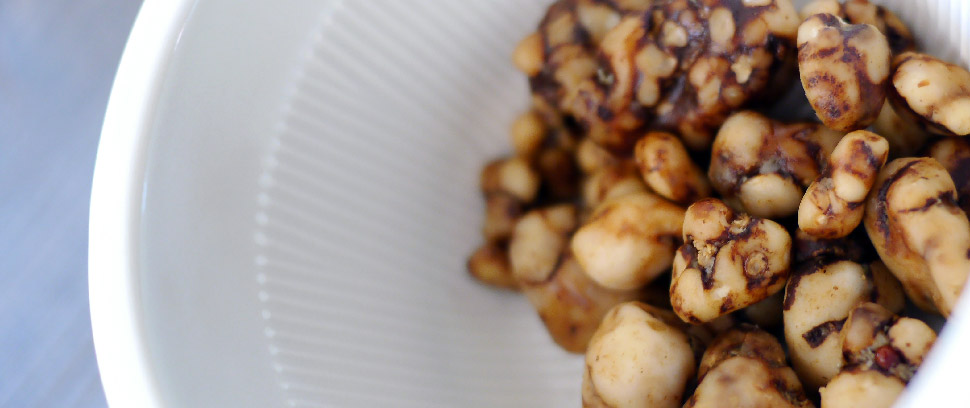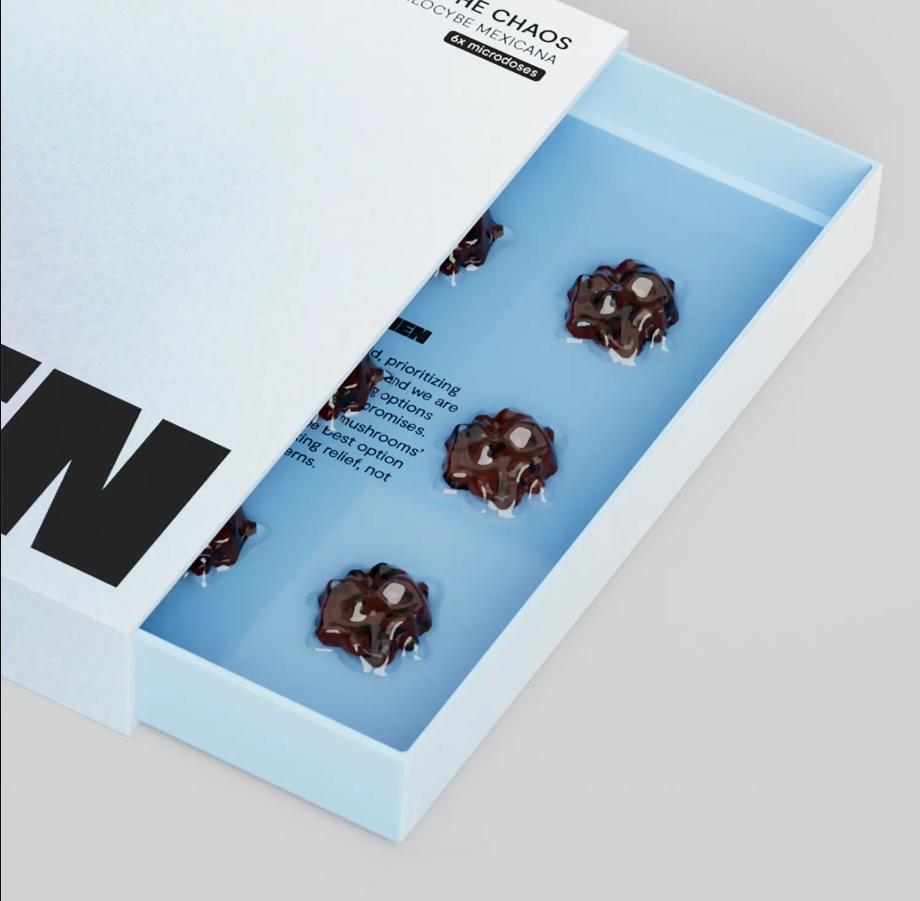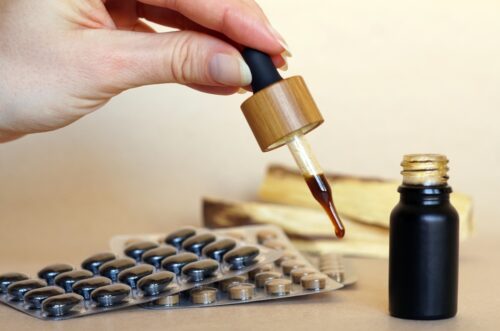Microdosing psilocybin truffles
What is Microdosing?
In the world of consumers of hallucinogenic mushrooms, there are two schools of thought. Those who seek transformative insights through psychedelic ceremonies. And others favor a measured approach, progressively exploring benefits via magic mushroom microdosing.
Many scientific studies show that taking a dose of psilocybin could play a beneficial role. Microdosing truffles could improve several cognitive functions and reduce symptoms of anxiety and depression, contributing to a healthier mindset. Indeed, the effects of a single intake of psychoactive molecules are a real boost to the psyche. But it’s sure that some people may have fears about an unknown and intense phenomenon.
Start your microdosing

3-week Microdose Kit
Promo code -10%: TANGERINE10
Buy magic truffles: Psilocybin truffle microdosing kits are payment2x by a reliable and legal supplier based in the Netherlands.
€44.99 | €49.99
- 6 grams of organic truffles in 1g portions.
- Dedicated application.
- 15-minute online coaching in English.
- Direct support line 7 days a week.
- Access to the BIEN community.
Classic dose and heroic dose
A classic psilocybin ceremony employs doses that vigorously stimulate serotonin and dopamine receptors. This activation profoundly awakens the central nervous system. The dose, ranging from 2 to 6 grams of magic mushrooms or 15 to 40 grams of truffles, induces significant effects. These include hallucinations, euphoria, and an intensified consciousness. Those who have tried it know: it’s mind-blowing but also challenging.
These heroic doses require being comfortable with the idea of a psychedelic trip. For example, they are intended for those who wish to turn to the secure environment of a legal retreat in the Netherlands.
Day-to-Day Mushroom
On the other hand, those who seek a gentle approach to magic-mushroom will lean towards microdosing truffles. This method is suits for those who want to take their time or are not looking for a major change.
A Microdosing protocol use the psychoactive molecule in small amounts. There is no psychedelic experience, no sensory journey or hallucinogenic effect. This dosage is sub-perceptible. That means without visible effects or tripping. Therefore, it does not interfere with one’s daily life.
The recurrent ingestion of small doses also aims at the emergence of subtle effects. In the medium term, psilocybin or LSD can enhance creativity or sense of well-being. Similarly, it could provide an alternative to depression treatment.
The Effects of Psilocybin Microdosing
Most of the time, practitioners do not suffer from treatment-resistant depression, as is sometimes the case with macrodosing.
Instead, they come from backgrounds marked by anxiety or recurrent episodes of depression. They also face a lack of motivation that impedes their ability to lead a fulfilling life. In all cases, those who experiment it are seeking two types of effects:
- Greater mental health and personal harmony by reducing negative thoughts and anxieties.
- Enhanced intellectual efficiency by boosting their creativity or problem solving capacities.
How is microdosing done?

Microdosing can be done in two forms: dried psilocybin capsules or pieces of fresh truffles that you prepare and measure yourself. In all cases, the dose used represents between 2% and 10% of the full dose.
| Desired Dose | Fresh Truffles | Dried Truffles |
|---|---|---|
| Light dose | 0.25-1 grams | 0.1-0.3 grams |
| High dose | 1-2 grams | 0.3-0.6 grams |
Dried Truffles
The amount of psilocybin present in capsules of dehydrated truffles depends greatly on their age, the drying process, and storage conditions. This makes the dosage somewhat unpredictable. So it’s quite challenging to determine if, when prepared this way, they are still fully effective.
However, they are easier to store and do not need regular replenishment. Thus, this is a suitable solution for people looking for simplicity above all.
Fresh Truffles
This second option is preferable for those who want to optimize its effectiveness. Fresh truffles have a better effect, and it is much easier to accurately measure the dose you are ingesting. However, preparation is more involved as you need to cut and weigh them yourself. Usually, it’s these truffles that one can order online.
How to Microdose Mushrooms Effectively ?
To successfully microdose magic truffles, you need to pay close attention to how you feel. If you experience nausea or lethargy, it’s advisable to space out your doses. A good dosage regimen should not induce negative effects and, most importantly, should not lead to suicidal thoughts.
There are primarily three protocols. One initiated by James Fadiman, another by Paul Stamets, and a third one favored to cut any side effects. All three recommend taking days off from dosing.
In a protocol, abstinence plays a key role: it prevents both the potential build-up of fatigue over time and, most importantly, safeguards against the development of tolerance, which could diminish the effects of psilocybin.
| Day | Fadiman | Paul Stamets Stack | Weekly procedure |
|---|---|---|---|
| 1 | Microdose | Microdose | Microdose |
| 2 | Enhancing the effects | Microdose | Rest |
| 3 | Rest | Microdose | Rest |
| 4 | Microdose | Microdose | Rest |
| 5 | Enhancing the effects | Rest | Rest |
| 6 | Rest | Rest | Rest |
| 7 | Rest | Rest | Rest |
| Duration | 4 to 6 weeks | 4 weeks, then 2 weeks off | 7 weeks, with 1 week off |
Microdosing and Psychotherapy
American author James Fadiman is one of the advocates of this method. In his book “The Psychedelic Explorer’s Guide,” he distinguishes the effects of psychedelics based on dosage:
“The heightened awareness offered by psychedelics comes in different forms.
At higher doses […], they facilitate the recognition of an intimate relationship with all living beings. At moderate doses, they facilitate awareness of the complex psychodynamic structures of individual consciousness. At low doses, they facilitate awareness of solutions to technical and artistic problems.”

Want to start a microdosing session ?
Order the microdosing starter kit with 3 weeks of psilocybin truffles and a live english-speaking coaching session.
Try microdosing
Paul Stamets Stack
Those of you who have seen the Netflix documentary “Fantastic Fungi” have already gained insight into Paul Stamets‘ extensive knowledge of mycology.
Recently, he has been proposing his own approach, known as the Stamets Stack. It involves the combination of three substances with complementary neurochemical properties.
Psilocybin, Lion’s Mane, and Niacin
The combination includes psilocybin, valued for its potential effects on mood and emotional openness. It combines with a non-psychedelic mushroom called Lion’s Mane or Yamabushitake. Lion’s Mane is a legal dietary supplement. Several studies have recognized it for its neuroprotective and neuroregenerative capabilities.
The Stamets Stack contains one final ingredient, niacin. This substance is more commonly known as vitamin B3. It helps the two previous compounds penetrate the nervous system to maximize their effects.
The Effects of the Stamets Stack
According to Paul Stamets, the combination of these three compounds has an overall improvement effect on the cognitive system. The author and mycologist mentions a decrease in anxiety and symptoms of depression or PTSD. The Stamets Stack is believed to help the brain process emotions better while aiding in the recovery of faculties impaired by emotional shocks.
The dosing schedule for the Stamets Stack is slightly different. The mycologist suggests taking it daily for four days, then abstaining for the next three days. And so on.
Reliable experimental feedback on the Stamets Stack is still limited. It is generally considered safe unless there is a specific contraindication to psilocybin.

Psychedelic Mushrooms and Depression
As a result of innovative research, psychedelic mushrooms are increasingly gaining interest as a potential alternative to antidepressant treatment.
Experiments with High Doses
Initial experiments conducted with high doses of psilocybin have been associated with long-lasting effects on mood improvement and motivation. They explain that psilocybin could have beneficial effects on depression symptoms by regulating neurotransmitter levels. Psilocybin acts on serotonin, the neurotransmitter associated with emotion regulation, like antidepressant medications.
On the other hand, individuals who microdose also report mood improvements, reduced anxiety, increased creativity, and enhanced concentration.
Psychedelic Research on Microdosing psilocybin
Microdosing magic truffles for treating depression and anxiety is increasingly gaining interest within the scientific community. Participants in several studies have often reported improvements in their emotional well-being and a reduction in anxiety symptoms.
However, the majority of these experiences are based on testimonials without direct evaluation, relying solely on the participants’ accounts.
Placebo Effect or Real Hope?
Thus far, the conclusions have been rather mixed, attributing the positive results to a placebo effect among a population already enthusiastic about consuming psychedelics.
For instance, a randomized study published in Nature evaluated 34 patients. Half of them received a microdose of psilocybin, while the other half received a placebo. While acknowledging slight changes in brain waves, scientists concluded that psilocybin did not demonstrate a definitive effect at these sub-perceptual doses and that only a higher dose could potentially offer therapeutic benefits. The observed effects would then be primarily due to placebo expectations.
Nevertheless, scientists need to conduct more rigorous research. A comprehensive assessment will serve to either confirm or refute the effectiveness and mechanisms of action of mushroom microdoses for depression, anxiety, or as support for intellectual performance. This does not deter many enthusiasts from continuing their own research in hopes of future discoveries.
A creativity booster?
In Silicon Valley, a handful of technology professionals use small doses to enhance their performance and better cope with pressure. In a challenging environment where managers expect flawless productivity, these men and women hope to unlock their potential and gain industry recognition through the use of LSD or psilocybin.
Steve Jobs’ autobiography also shares how LSD enabled him to unleash his creativity. This leads him to generate revolutionary ideas such as the Macintosh and iPod.
Potential Risks and Safety
In general, psilocybin small doses are considered safe. Thus far, scientific documentation has not reported any cases of dependency, addiction. Also there’s no adverse effects on memory (unlike cannabis or benzodiazepines). However, caution is still advised. For safety, it is therefore wise to understand the medical implications before consuming psychoactive substances, even in small quantities.
Since microdoses are very low, the risk of overdose is minimal, if not non-existent. However, initial doses may cause headaches, restlessness, nausea, or a slight increase in anxiety. If uncomfortable symptoms or behavioral disturbances occur, it is advisable to stop the protocol immediately.
Antidepressants and Psychotic Individuals
Even more importantly, there’s a strict contraindication for individuals taking selective serotonin reuptake inhibitors (SSRIs) such as Prozac or monoamine oxidase inhibitors (MAOIs).
To avoid unpleasant or dangerous interactions during a psilocybin microdosing protocol, it is necessary to undergo medication withdrawal under the supervision of a general practitioner or psychiatrist.
Similarly, psilocybin in all its forms is not a good option for individuals suffering from psychosis, heart failure, or those taking antipsychotic medications. These contraindications also apply to the Stamets Stack.
Information to Know Before Starting
Perhaps the best way to harness the potential of microdoses of magic mushrooms is to work with a professional in psychology or personal development. Psilocybin leads to an increase in brain plasticity, making it easier to implement changes. During psychotherapy, for example, a patient on a microdose will be more receptive and able to delve deeper into self-exploration.
The challenge with psilocybin microdosing lies in the fact that the potency of mushrooms can vary from one specimen or dealer to another. In the absence of precise regulation on the production of psychedelic mushrooms, it is generally less precise than a ceremony with magic truffles but remains a simpler and more cost-effective alternative.
The Rules for Safe Microdosing
Before starting such a regimen, it is important to adhere to a few rules. For example, never initiate the protocol on a workday, let alone if you need to drive. Similarly, experienced individuals recommend following a regular schedule and keeping a microdosing journal to record sensations, doses, benefits, or difficulties.
In general, the body and mind are good indicators of the potential effects. Any positive or negative reactions should be taken into account to adjust the doses or frequency.
LSD: A Complex Endeavor
LSD is typically available in liquid form and is clandestinely prepared. It can be challenging to precisely know the dose being consumed unless one has an extremely reliable supplier. Therefore, microdosing LSD is an endeavor that requires a great deal of caution and a genuine understanding of the sourcing process.
Frequently Asked Questions about microdosing truffles
How to order magic mushrooms?
Several websites, including this one, offer to buy magic mushroom truffles. Buying online allows for direct home delivery in discreet packaging. However, be careful to comply with the law in force where you receive your order.
Also note that in the Netherlands, only truffles are legal.
Is it safe to Microdose for Depression?
For most people, this approach is risk-free, not addictive and even not trippy. However, there are specific cases. For those, the consumption of psilocybin poses little risk. However, individuals with psychotic disorders such as schizophrenia or dissociative identity disorder should avoid taking psychedelics. Similarly, its interaction with heart or kidney failure is poorly understood and warrants caution. Finally, there is also a contraindication for microdosing magic mushrooms for those on antidepressant or anti-diabetic treatments.
The molecule is a controlled-substance. So, there is still a legal risk if you consume psilocybe capsules or extracts in a country where it is prohibited. LSD, on the other hand, is prohibited everywhere.
Does Microdosing Mushrooms Work for Depression?
At this stage of research, the answer is rather. It is unsure if this method does or not have an effect on depression, unlike higher doses. Studies on medical-use have shown mixed results.
But, one study conducted in 2021 nevertheless concludes it does. This protocol says that “adults who microdose psychedelics report lower levels of anxiety and depression.”
How to Start to Microdose Mushrooms for Depression?
To start a protocol as an alternative to depression treatment, there are four steps:
- Educate yourself about the legality of psilocybin and the risks involved.
- Consult with a healthcare professional (psychiatrist) to determine if you can undertake such an approach and establish a dosing frequency.
- Research reliable sources for obtaining mushrooms online. There’s a lot of valuable information on Reddit or Erowid.
- Always prefer a microdosing kit from a recognized and legal retailer.
- Find a trusted individual or healthcare professional to whom you can regularly report any potential side effects you encounter.
Is it legal to microdose for depression?
The legality of mushroom microdosing depends on the legality of psilocybe mushrooms in the region of the world where you live. Even though it’s possible to order mushroom truffles online, it’s always necessary to check the legality of this action.
In the Netherlands, Colorado, or Oregon, you can practice it legally for personal or psychitherapeutic purposes. Spain and Italy have some tolerance for private use. France, Germany, and Belgium strictly prohibit any use.
How Long Does It Take for Microdosed Mushrooms to Have an Effect on Depression?
The ingestion of magic mushrooms or psychedelic truffles typically produces effects within about 30 minutes. In the case of microdosing psilocybin mushroom, you are unlikely to feel any specific changes after a single dose. If effects do occur, they will be subtle. They may take a few days to manifest.
Can microdosing cause a bad trip?
Consuming hallucinogens in microdoses does not cause a bad trip. It does not lead to a deep mind altering. It does not influence past emotions. However, it can catalyze certain everyday emotions and make one more relaxed, more tender, or even colder.

